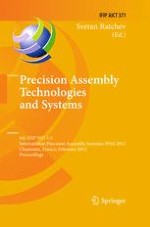2012 | Book
Precision Assembly Technologies and Systems
6th IFIP WG 5.5 International Precision Assembly Seminar, IPAS 2012, Chamonix, France, February 12-15, 2012. Proceedings
Editor: Svetan Ratchev
Publisher: Springer Berlin Heidelberg
Book Series : IFIP Advances in Information and Communication Technology
